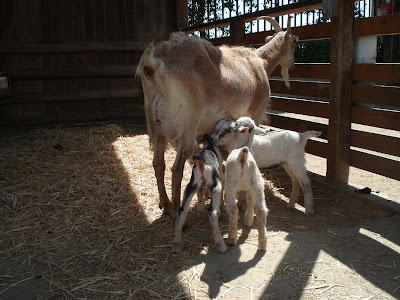We recently borrowed The Big Red Barn by Margaret Wise Brown from the library for my two year old. There is a lot for little ones to find as you read it to them…
Here’s another one of our favorite farm books. If you don’t have it already, just buy it. You’ll love it and your kids will too. While some may claim it twaddle, I must disagree in that there are complex human conditions subtly weaved throughout 🙂 And even if it is, I’m okay with this one on my shelf because it’s just that good.
Real, open spaced, sprawling farms where animals roam freely are hard to come by locally for us, but we do have a ‘field trip’ type farm where the kids can touch and see the different animals. And this time of year, they have babies. Best of all, entry and parking are free so there’s really no reason not to go.
You can learn many of the male/female names of the animals and the birth dates and due dates are also listed. I never knew a ‘Peacock’ only applied to the male bird and that the female is called a ‘Peahen’, did you?
These kids were only a few days old. My 8yo daughter told me they are drinking that ‘delicious’ milk like Heidi – the free read we just finished. She does often make those connections without me pointing them out for her. I can’t say I’m always able to hold my tongue – because I’m just as excited about the books and making those connections, but when I do I’m glad, because it delights her to discover something herself.
You can touch and feel all the animals. They’re very friendly.
And just look at that Momma!
They have a few rows of vegetables planted.
I never knew brussel sprouts grew like this:
We saw a real yoke, which we just read about in Tree in the Trail for YR2. This one isn’t quite as fancy.
Isn’t it great to be able to leisurely stroll through places like this with our kids on a weekday? Without crowds, without the rush-rush of having to be anywhere, without a textbook of information we have to get through, without a lengthy lecture on the environmental benefits of farming a particular way.
Don’t get me wrong, I do want my kids to learn these things, just not that way, and just not at the expense of extinguishing their natural appetite to learn.
In Vol. 3 of Charlotte Mason’s Original Homeschooling Series, she writes about how we are “Educated by our Intimacies”:
Our Limitations.––Most thinking people are in earnest about the bringing up of children; but we are in danger of taking too much upon us, and of not recognising the limitations which confine us to the outworks of personality. Children and grown-up persons are the same, with a difference; and a thoughtful writer has done us good service by carefully tracing the method of our Lord’s education of the Twelve.
“Our Lord,” says this author, “reverenced whatever the learner had in him of his own, and was tender in fostering this native growth––. . . . Men, in His eyes, were not mere clay in the hands of the potter, matter to be moulded to shape. They were organic beings, each growing from within, with a life of his own––a personal life which was exceedingly precious in His and His Father’s eyes––and He would foster this growth so that it might take after the highest type.” (Pastor Pastorum, by H. Latham, M.A., page 6.) ~CM’s Original Homeschooling Series, Vol. 3 p. 183
Our deadly error is to suppose that we are his showman to the universe; and, not only so, but that there is no community at all between child and universe unless such as we choose to set up. ~p. 188
She goes on for three chapters, quoting the writings of Wordsworth and Ruskin, pointing out the things that became life-shaping intimacies for them. I can assure you, it was not dull, prefabricated lectures!
It was following their curiosity, making their own discoveries, having their own grand adventures – sustained with healthy discipline, atmosphere, and living ideas from wonderful books. It is the very thing that goes to make the child a person, what is theirs by Divine right. And CM is very passionate about not meddling with or squelching it.







